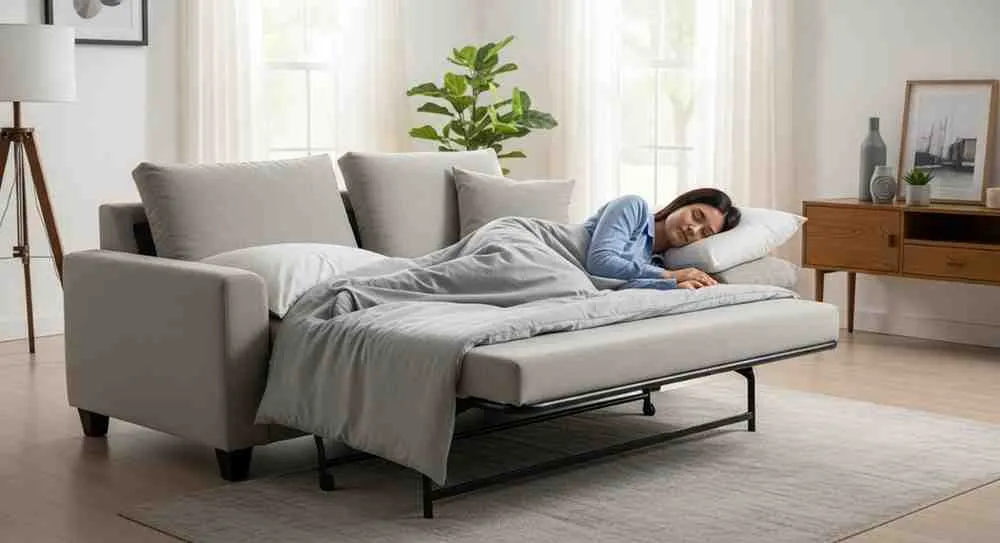INTRODUCTION
You’ve pulled out the sofa bed for guests, settled in for the night yourself, or tried to catch a quick nap—only to wake up with a sore back, stiff neck, and regret. If you’ve ever slept on a pull-out couch, you know the struggle is real. That thin mattress, the infamous metal bar digging into your spine, and the awkward angles can transform what should be a restful night into an uncomfortable ordeal.
But here’s the good news: you don’t have to suffer through another sleepless night on your pull-out couch. With the right techniques, affordable additions, and smart hacks, you can transform even the most uncomfortable sofa bed into a surprisingly cozy sleeping space. Whether you’re accommodating overnight guests, living in a small apartment, or simply need a backup sleeping option, this comprehensive guide will show you exactly how to make a pull out couch more comfortable.
Understanding Why Pull-Out Couches Are Uncomfortable
Before diving into solutions, it’s helpful to understand what makes pull-out couches so notoriously uncomfortable in the first place.
The Thin Mattress Problem
Most pull-out couches come with mattresses that are only 4-5 inches thick—significantly thinner than a standard mattress (which ranges from 8-14 inches). This minimal cushioning means you’re much closer to the hard metal frame underneath, leading to pressure points and discomfort throughout the night.
The Metal Bar Issue
The metal support bar that runs horizontally across many pull-out couches is perhaps the most infamous design flaw. This bar creates an uncomfortable ridge right where your lower back or hips rest, causing pain and disrupting sleep quality.
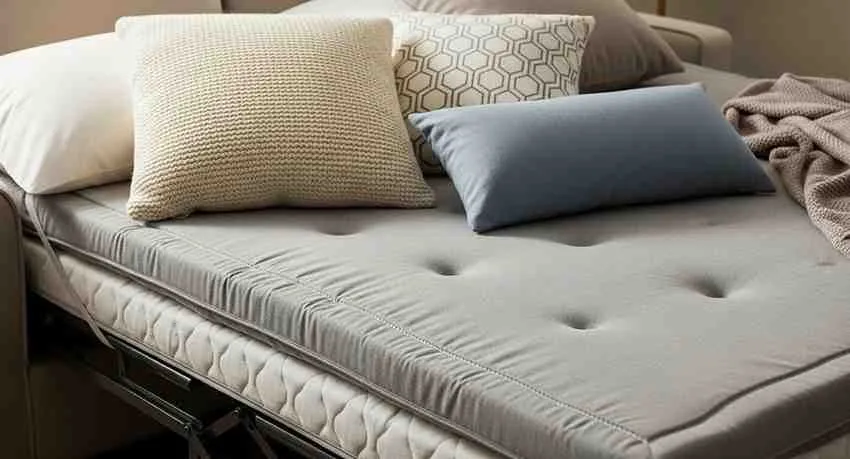
Poor Support and Sagging
Over time, pull-out couch mattresses compress and lose their supportive qualities. The combination of thin foam, frequent folding, and weight compression creates sagging spots that offer inadequate spinal support—a recipe for waking up with aches and pains.
Awkward Sleeping Surface
Unlike a proper bed with a box spring and mattress system, pull-out couches often create an uneven sleeping surface with gaps, lumps, or slanted areas where the mattress folds. These irregularities make it difficult to find a comfortable sleeping position.
Limited Breathability
The materials used in many sofa bed mattresses don’t breathe well, leading to heat retention and uncomfortable sleeping temperatures—especially problematic for those who naturally sleep warm.
Essential Tips for Sleeping on a Pull-Out Couch Without Back Pain
Let’s start with the fundamentals—strategies that address the most common comfort issues and help prevent that dreaded morning back pain.
Invest in a Quality Mattress Topper
This is hands-down the most effective upgrade you can make. A mattress topper adds crucial cushioning and support that transforms the sleeping experience.
Best Mattress Toppers for Pull-Out Couches:
- Memory foam toppers (2-4 inches thick): Conform to your body, relieve pressure points, and cushion that metal bar. Memory foam excels at distributing weight evenly.
- Gel-infused foam toppers: Offer memory foam benefits with improved temperature regulation—ideal if you sleep hot.
- Latex toppers: Provide firmer, more responsive support with excellent breathability and durability.
- Feather or down toppers: Create a plush, hotel-like sleeping surface, though they offer less structural support than foam options.
For pull-out couches, aim for a 2-3 inch topper as a minimum. Thicker toppers (3-4 inches) provide maximum comfort but may create fitting issues when folding the couch back up.
Address the Metal Bar Strategically
The infamous metal bar requires targeted solutions:
Folded Blanket Method: Place a thick, folded blanket, comforter, or yoga mat directly over the metal bar area before adding sheets. This creates a buffer zone that prevents the bar from digging into your back or hips.
Pool Noodle Hack: Cut a pool noodle lengthwise and position it over the metal bar, then cover with your mattress topper or sheets. This DIY solution is surprisingly effective and costs just a few dollars.
Pillows as Barriers: Strategic pillow placement along the bar area can provide localized cushioning. Use firm pillows for better support.
Optimize Your Sleeping Position
How you position yourself matters significantly:
Side Sleeping: If you’re a side sleeper, position yourself so the metal bar falls between your ribs and hips rather than directly under your hip bone. Use a pillow between your knees for added spine alignment.
Back Sleeping: Place a pillow under your knees to maintain natural spine curvature and reduce lower back pressure. Ensure your head pillow keeps your neck aligned without tilting too far forward.
Stomach Sleeping: While generally not recommended for spinal health, if you must sleep on your stomach, place a thin pillow under your hips to prevent excessive lower back arching.
Add Supportive Bedding Layers
Creating a proper sleeping surface involves strategic layering:
- Base layer: Start with a mattress topper (memory foam, latex, or gel)
- Protective layer: Add a mattress pad or waterproof protector
- Comfort layer: Use quality fitted sheets (cotton or bamboo for breathability)
- Insulation layer: Add a mattress pad or thin blanket if the surface feels too firm
- Top bedding: Finish with comfortable blankets and a duvet appropriate for the season
This layering approach allows you to customize firmness and comfort while protecting your investment.
Best Ways to Turn a Pull-Out Couch Into a Sleep-Friendly Space
Beyond addressing the mattress itself, creating an overall sleep-conducive environment makes a significant difference.
Invest in Proper Pillows
Never underestimate the power of good pillows. Your neck and head support directly impacts sleep quality and whether you wake up pain-free.
Pillow Selection Tips:
- Use a pillow that keeps your neck aligned with your spine (not tilted up or down)
- Side sleepers need thicker, firmer pillows
- Back sleepers benefit from medium-loft pillows
- Consider a body pillow for added support and comfort
- Keep 2-3 pillow options available for guests with different preferences
High-quality pillows filled with memory foam, latex, or down alternative can dramatically improve the sleeping experience on any surface, including pull-out couches.
Create a Bedding Station
If you use your pull-out couch regularly, organize a dedicated bedding station:
- Store sheets, blankets, and pillows in a nearby closet or ottoman
- Keep the mattress topper rolled nearby for easy access
- Use vacuum-sealed storage bags to save space
- Designate a specific set of bedding just for the pull-out couch
This organization makes setup quick and ensures you’re not scrambling for supplies when guests arrive or you need a quick nap.
Adjust Room Temperature and Airflow
Sleep quality heavily depends on environmental factors:
Optimal Sleep Temperature: Keep the room between 60-67°F (15-19°C) for best sleep quality. Pull-out couches often trap heat, so err on the cooler side.
Improve Airflow: Position a fan nearby to promote air circulation. This prevents stuffiness and helps regulate body temperature throughout the night.
Use Breathable Fabrics: Choose cotton, linen, or bamboo sheets rather than synthetic materials. These natural fibers wick moisture and promote better temperature regulation.
Block Light and Minimize Noise
Living room sleeping solutions require addressing environmental disruptions:
- Install blackout curtains or use a sleep mask
- Use white noise machines or apps to mask household sounds
- Consider earplugs if you’re sleeping in a high-traffic area
- Position the pull-out couch away from direct light sources when possible
Establish a Routine
Even when sleeping on a pull-out couch, maintaining sleep hygiene matters:
- Go to bed and wake at consistent times
- Avoid screens 30-60 minutes before sleep
- Keep the space tidy and dedicated to sleep when the couch is extended
- Use calming scents like lavender to signal bedtime
- Dim lights in the evening to promote natural melatonin production
Couch Mattress Hacks for Maximum Comfort
Let’s explore creative, budget-friendly solutions that enhance pull-out couch comfort without major investments.
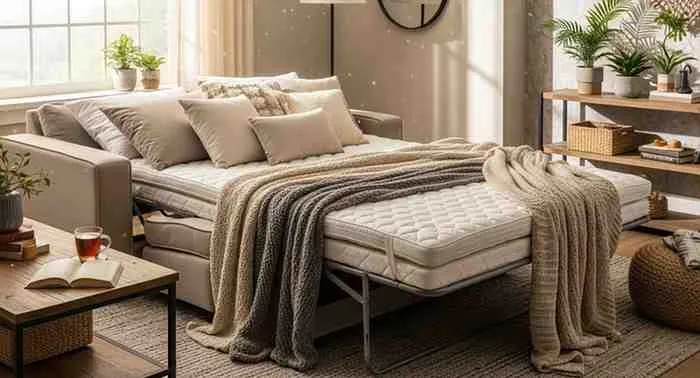
The Egg Crate Foam Solution
Egg crate foam (convoluted foam) provides affordable cushioning with enhanced airflow:
- Available at most home goods stores for $20-40
- Creates air pockets that improve breathability
- Softens the sleeping surface and reduces pressure points
- Can be cut to size for perfect fitting
- Lightweight and easy to store when not in use
Place the egg crate foam directly on the pull-out mattress, with the bumpy side facing up, before adding sheets.
DIY Mattress Pad Creation
Create a custom comfort layer using materials you may already have:
Quilted Blanket Method: Layer 2-3 thick quilts or comforters on the pull-out mattress. Secure them with sheet clips or safety pins to prevent shifting during sleep.
Sleeping Bag Liner: Use a sleeping bag (unzipped and laid flat) as a cushioning layer. The insulation provides both softness and warmth.
Yoga Mat Base: Place yoga mats or exercise mats underneath your sheets for added cushioning and to create a smoother surface over the metal frame.
The Sheet Clip Strategy
Regular sheets often don’t fit pull-out couch mattresses properly, leading to bunching and discomfort. Use:
- Adjustable sheet clips or straps to secure sheets tightly
- Deep-pocket sheets designed for thicker mattresses
- Sheet suspenders that attach to all four corners
- Flat sheets tucked hospital-corner style for a smooth surface
Properly secured sheets eliminate wrinkles and bunching that create uncomfortable lumps during sleep.
Temperature Regulation Hacks
If your pull-out couch sleeps hot:
Cooling Gel Pad: Place a cooling gel pad (designed for hot flashes or summer sleep) on top of the mattress before adding sheets.
Moisture-Wicking Mattress Protector: Invest in a protector designed with cooling technology and moisture-wicking properties.
Breathable Mattress Topper: Choose a latex or gel-infused memory foam topper rather than traditional memory foam, which retains more heat.
Lightweight Bedding: Use breathable cotton or linen sheets and lightweight blankets rather than heavy comforters.
The Plyboard Support Method
For seriously sagging pull-out couch mattresses, add structural support:
- Purchase a thin piece of plywood cut to fit your mattress dimensions
- Place it between the mattress and metal frame
- Add your mattress topper on top
- This creates a firm, even base that prevents sagging and improves overall support
This solution works particularly well for older pull-out couches with worn-out mattresses.
Improve Couch for Sleeping: Long-Term Solutions
If you regularly use your pull-out couch for sleeping, consider these more substantial upgrades.
Replace the Mattress Entirely
Most pull-out couch mattresses are replaceable. Consider upgrading to:
Memory Foam Replacement Mattress: Custom-cut memory foam mattresses (5-6 inches thick) dramatically improve comfort while still folding properly.
Hybrid Sofa Bed Mattress: Combines foam and innerspring elements for better support and durability.
Gel Memory Foam Options: Offer superior temperature regulation compared to standard foam.
Replacement mattresses typically cost $200-500 but transform your pull-out couch into a genuinely comfortable sleeping option. Measure your existing mattress carefully before ordering to ensure proper fit.
Install a Mattress Support System
Some companies manufacture support systems specifically designed for pull-out couches:
- Metal reinforcement bars that add structure
- Inflatable support systems that provide customizable firmness
- Wooden slat systems that replace or reinforce the existing frame
These solutions address structural deficiencies that cause sagging and poor support.
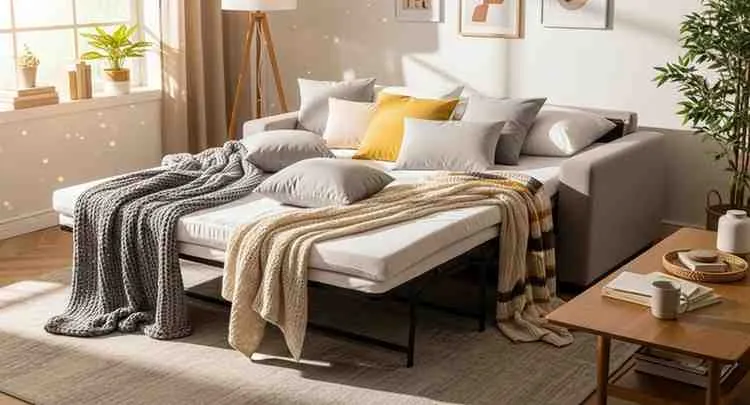
Consider a Pull-Out Couch Upgrade
If you’re in the market for a new sofa bed or can justify the investment:
What to Look For:
- Thicker mattresses (6+ inches minimum)
- High-density foam or hybrid spring systems
- Sturdy metal frames with strong support bars
- Quality construction that prevents sagging
- Easily replaceable mattress components
Modern, higher-end pull-out couches have addressed many traditional comfort issues. Brands like American Leather, Room & Board, and Pottery Barn offer significantly more comfortable options than budget models.
Maintain Your Pull-Out Couch
Regular maintenance extends comfort and longevity:
- Rotate the mattress periodically (if possible) to prevent uneven wear
- Vacuum the mattress and frame to remove dust and debris
- Air out the mattress monthly to prevent moisture buildup
- Tighten loose screws and hardware in the frame
- Address squeaks with lubricant on metal joints
- Replace worn mattresses every 5-7 years
Sleeping on Couch Comfort: Special Considerations
Different situations require tailored approaches to maximizing pull-out couch comfort.
For Overnight Guests
When hosting visitors on your pull-out couch:
Pre-Guest Preparation:
- Set up the couch bed completely before guests arrive
- Provide multiple pillow options (firm, soft, different heights)
- Include extra blankets for temperature preferences
- Add a bedside lamp or reading light
- Provide a glass of water and small guest amenities
- Ensure privacy with curtains or room dividers if needed
The Host’s Touch:
- Ask about sleep preferences (firm vs. soft, warm vs. cool)
- Demonstrate how to adjust the pull-out mechanism
- Show where extra bedding is stored
- Provide ear plugs and eye masks as options
- Check in after the first night to make adjustments
For Regular Use or Small Space Living
If your pull-out couch serves as your primary bed:
Invest Appropriately: Don’t skimp on quality mattress toppers, pillows, and bedding. Your sleep quality directly impacts health and wellbeing.
Create Separation: Even in small spaces, establish a boundary between “couch mode” and “bed mode” mentally and physically. Store daytime clutter elsewhere when sleeping.
Consider Alternatives: If using a pull-out couch long-term causes persistent discomfort, explore Murphy beds, daybed options, or higher-quality sofa beds designed for regular use.
Protect Your Investment: Use a waterproof mattress protector and wash bedding regularly to extend the life of your comfort upgrades.
For Children or Teenagers
Younger sleepers have different needs:
- Children often find pull-out couches more comfortable than adults due to lower body weight
- Create a “special” sleeping space with fun bedding to make it appealing
- Ensure safety with guardrails if children are very young or restless sleepers
- Allow kids to help set up their cozy sleeping space
- Keep a nightlight nearby for comfort and safety
For People with Back Problems
If you have existing back issues:
Firmness is Key: Prioritize firm support over soft cushioning. Use a latex topper or add a plyboard base for extra support.
Proper Alignment: Focus on maintaining neutral spine alignment with strategic pillow placement under knees (back sleepers) or between knees (side sleepers).
Elevation: Slightly elevate your legs with pillows to reduce lower back pressure.
Consult Healthcare Providers: If you’ll be sleeping on a pull-out couch for extended periods due to circumstance, discuss strategies with your doctor or physical therapist.
Morning Stretches: Implement a gentle stretching routine upon waking to ease stiffness and prevent lasting discomfort.
Cozy Couch Setup: Creating the Perfect Sleep Environment
Beyond physical comfort, the overall ambiance affects sleep quality.
Bedding Choices That Make a Difference
Thread Count Matters: For sheets, aim for 300-500 thread count. Higher isn’t always better—extremely high thread counts can feel stiff and trap heat.
Natural Fibers: Cotton, linen, and bamboo sheets breathe better than polyester blends, keeping you more comfortable throughout the night.
Weight and Warmth: Choose blanket weight based on season and personal preference. Heavy blankets provide comforting pressure but may be too warm for some sleepers.
Texture Considerations: Soft, smooth textures promote relaxation. Avoid scratchy or rough fabrics that can disrupt sleep.
Lighting and Ambiance
Transform your living room into a sleep sanctuary:
- Use dimmable lamps or string lights for gentle evening lighting
- Position lighting to avoid direct glare on the sleeping surface
- Consider sunrise alarm clocks that gradually increase light for natural waking
- Use candles (safely extinguished before sleep) or essential oil diffusers for calming scents
Personal Touches
Small additions create a more inviting sleep space:
- A small side table for water, phones, and glasses
- A basket with sleep essentials (eye mask, earplugs, hand lotion)
- Fresh flowers or plants to improve air quality and aesthetics
- Soft throw blankets in attractive colors for layering
- Decorative pillows that can be removed at bedtime but add daytime appeal
Comparison: Pull-Out Couch vs. Air Mattress vs. Regular Couch Sleep
Understanding your options helps you make the best choice for your situation.

Pull-Out Couch with Upgrades
Pros:
- Dual functionality (seating and sleeping)
- Space-saving in small homes
- Can be made quite comfortable with proper modifications
- More stable than air mattresses
- Maintains room aesthetics
Cons:
- Requires setup and takedown
- Initial discomfort without upgrades
- Mechanism can be heavy and awkward
- Limited mattress thickness compared to regular beds
Air Mattress
Pros:
- Highly portable and storable
- Adjustable firmness on some models
- Affordable option
- Can accommodate different sizes easily
Cons:
- Requires inflation before each use
- Can develop leaks over time
- Often produces noise with movement
- May lose air overnight requiring adjustment
- Less stable than pull-out couches
- Cold to sleep on without insulation
Sleeping on Regular Couch (Not Pulled Out)
Pros:
- No setup required
- Immediate availability for naps
- Cushioned surface
- Cozy for short rest periods
Cons:
- Poor spinal alignment for overnight sleep
- Risk of falling off
- Back and cushions create uneven surface
- Not suitable for guest accommodation
- Can damage couch cushions over time
- No proper bedding setup
The Verdict: For overnight sleep, a properly upgraded pull-out couch offers the best balance of functionality, comfort, and practicality—especially for regular use or hosting guests.
Real-Life Success Stories: People Who Transformed Their Pull-Out Couches
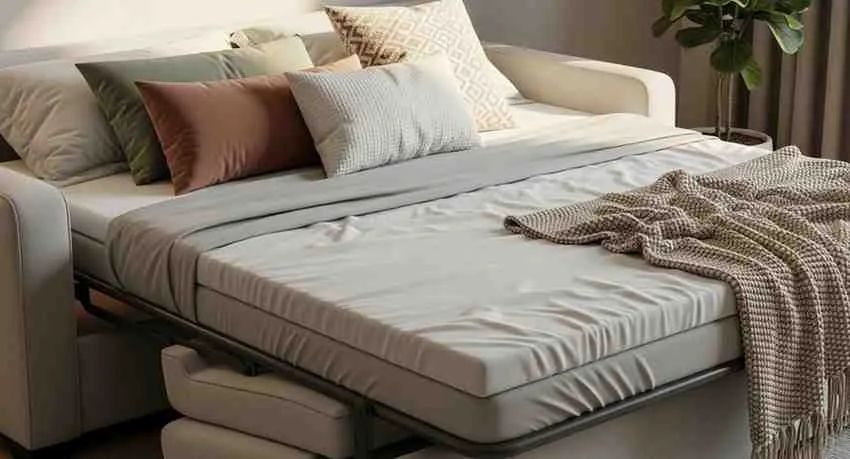
Sarah’s Studio Apartment Solution
Sarah, a 28-year-old living in a New York City studio, shares: “I was waking up with terrible back pain every morning. I couldn’t afford a Murphy bed, so I invested $150 in a 3-inch memory foam topper and quality sheets. The difference was night and day. I also started using a body pillow for extra support. Now I actually sleep well, and my back pain has almost completely disappeared. The key was treating my pull-out couch like a real bed, not just a temporary solution.”
The Thompson Family’s Guest Room Makeover
The Thompson family hosts relatives several times a year: “We realized our guests were uncomfortable but too polite to say anything. We upgraded everything—new replacement mattress, mattress topper, hotel-quality bedding, blackout curtains, and a white noise machine. Now our guest room is so comfortable that my sister-in-law actually requests to sleep on the pull-out couch instead of the regular bedroom. It’s become a point of pride for us.”
Marcus’s Gaming Room Transformation
Marcus, a college student, converted his gaming space into a dual-purpose room: “I was crashing on my pull-out couch between classes and gaming sessions. The metal bar was killing me. I used the pool noodle hack and added an egg crate foam topper—total cost was under $40. I also started storing my bedding in a decorative basket so setup takes less than two minutes. Now my friends actually want to sleep over because they know they’ll be comfortable.”
Frequently Asked Questions
How can I make my pull-out couch more comfortable for sleeping?
The most effective method is adding a 2-4 inch memory foam or latex mattress topper, which cushions the metal frame and provides proper support. Combine this with addressing the metal bar using folded blankets or pool noodles, investing in quality pillows, and using breathable bedding for optimal comfort.
What are the best ways to sleep on a pull-out couch overnight?
Focus on three key areas: add cushioning with a mattress topper, maintain proper spinal alignment with supportive pillows, and create a sleep-friendly environment with appropriate temperature, darkness, and minimal noise. Position yourself to avoid the metal bar pressure points, and use multiple bedding layers for customized comfort.
Can couch cushions be optimized for better sleep?
While you can’t significantly modify the existing couch cushions, you can add layers on top to improve comfort. Mattress toppers, folded quilts, yoga mats, or egg crate foam create a more supportive sleeping surface. For long-term use, consider replacing the entire pull-out mattress with a higher-quality option.
Is it better to use a mattress topper on a pull-out couch?
Absolutely. A mattress topper is the single most effective upgrade for pull-out couch comfort. Memory foam toppers excel at pressure relief and cushioning the metal bar, while latex toppers provide firmer, more responsive support with better breathability. Even a modest 2-inch topper dramatically improves sleep quality.
How do I prevent back pain when sleeping on a pull-out couch?
Prevent back pain by ensuring proper support (mattress topper or firm underlayer), maintaining spinal alignment with strategic pillow placement, addressing the metal bar directly with cushioning, and sleeping in positions that support natural spine curvature. If you’re a back sleeper, place a pillow under your knees; side sleepers should use a pillow between their knees.
What thickness mattress topper is best for pull-out couches?
For most people, a 2-3 inch topper provides the ideal balance of comfort, support, and practicality. This thickness adequately cushions the metal bar and frame while still allowing the couch to fold back up easily. If you weigh over 200 pounds or have significant back pain, consider a 3-4 inch topper for extra support.
How often should I replace my pull-out couch mattress?
Replace your pull-out couch mattress every 5-7 years with regular use, or sooner if you notice significant sagging, loss of support, or persistent discomfort. Signs it’s time for replacement include visible indentations that don’t bounce back, waking with pain despite comfort modifications, or the mattress feeling notably thinner than when new.
Can a pull-out couch be as comfortable as a regular bed?
With proper modifications—quality mattress topper, supportive pillows, appropriate bedding, and environmental controls—a pull-out couch can approach regular bed comfort for occasional use. However, for nightly, long-term sleeping, a proper bed with a full mattress and box spring system typically provides superior comfort and support. That said, higher-end pull-out couches with thick mattresses can be surprisingly comfortable.
Conclusion: Your Path to Pull-Out Couch Comfort
Transforming an uncomfortable pull-out couch into a sleep-friendly haven doesn’t require breaking the bank or accepting restless nights. By implementing even a few of the strategies outlined in this guide—starting with a quality mattress topper, addressing that notorious metal bar, optimizing your bedding setup, and creating a proper sleep environment—you can dramatically improve your sleep quality on any pull-out couch.
Remember that comfort is personal. What works perfectly for one person might not suit another, so don’t be afraid to experiment with different combinations of toppers, pillows, and positioning strategies until you find your ideal setup. Start with the basics—a good mattress topper and proper pillows—then layer in additional modifications based on your specific comfort needs and budget.
Whether you’re preparing for guests, living in a small space, or simply maximizing your home’s functionality, a comfortable pull-out couch represents a valuable asset. With the right approach, that dreaded sofa bed can become a genuinely restful sleeping option that you and your guests actually look forward to using.
What’s your biggest pull-out couch comfort challenge? Have you tried any of these hacks, or do you have your own tips to share? Drop a comment below with your experiences, and don’t forget to share this article with anyone who could use a better night’s sleep on their sofa bed. For more home comfort solutions and lifestyle improvements, explore our related articles on optimizing your living space for maximum coziness and functionality.
Sweet dreams—even on the pull-out couch!



